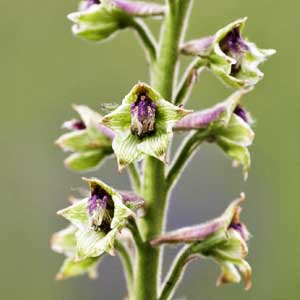Delphinium viridescens
Delphinium hesperium
Wenatchee larkspur
foothill larkspur, western larkspur
90-150 cm;
base usually green, glabrous.
(11-)40-80(-120) cm;
base usually reddish, longitudinally ridged, puberulent.
blade cuneate to semicircular, 2-5 × 3-12 cm, nearly glabrous; ultimate lobes 3-21, width 1-8 mm.
blade round to pentagonal, 1-4 × 2-6 cm, usually puberulent, especially abaxially; ultimate lobes 3-14, width 3-8 mm (basal), 2-5 mm (cauline).
25-80-flowered, dense;
pedicel 0.5-2 cm, glandular-pubescent;
bracteoles 1-4 mm from flowers, green, lanceolate, 3.5-6 mm, glandular-pubescent.
(5-)15-30(-100)-flowered, moderately open;
pedicel (0.5-)1-2.5(-7.5) cm, puberulent;
bracteoles 2-6(-12) mm from flowers, green to blue, margins often white, linear-lanceolate, 3-7(-12) mm, puberulent.
sepals yellowish green, nearly glabrous, lateral sepals forward pointing, 7-9 × 3-4 mm, spurs decurved, 30-45° below horizontal, often hooked apically, 8-11 mm;
lower petal blades ± covering stamens, 4-6 mm, clefts 0.5-1.5 mm;
hairs centered, mostly near junction of blade and claw, yellow.
sepals dark blue to white, puberulent, lateral sepals spreading, 7-13(-16) × 3-10 mm, spurs straight to upcurved, ascending 30-45° above horizontal, 9-18 mm;
lower petal blades slightly elevated, ± exposing stamens, 3-8 mm, clefts 1-5 mm;
hairs centered, denser on inner lobes near base of cleft, white.
8-11 mm, 2.5-3 times longer than wide, puberulent.
8-18 mm, 2.2-3(-4.2) times longer than wide, sparse puberulent.
± wing-margined;
seed coat cells with surfaces ± roughened.
not echinate, appearing ± smooth to naked eye;
seed coat cells with margins straight, surfaces smooth or roughened.
Delphinium viridescens
Delphinium hesperium
Of conservation concern.
Delphinium viridescens is local in mountains southwest of Wenatchee, Washington.
(Discussion copyrighted by Flora of North America; reprinted with permission.)
Subspecies 3 (3 in the flora).
Delphinium hesperium is thought to be poisonous to cattle (D. E. Moerman 1986, no subspecies specified). It is often confused with D. hansenii. See discussion under that species for distinguishing features.
(Discussion copyrighted by Flora of North America; reprinted with permission.)
1. Lateral sepals 4(–5) mm wide or less; inflorescence dense (individual flowers often touching in pressed specimens). | subsp. cuyamacae |
1. Lateral sepals more than 4 mm wide; inflorescence open (individual flowers seldom touching in pressed specimens). | → 2 |
2. Sepals dark blue-purple. | subsp. hesperium |
2. Sepals white to pinkish, rarely light blue. | subsp. pallescens |


